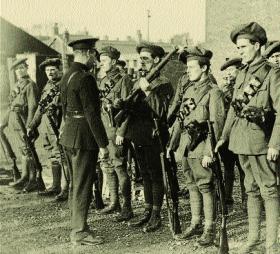Black-and-Tans
Published in 20th-century / Contemporary History, Issue 2 (Mar/Apr 2005), Letters, Letters, Volume 13
Is the date ‘25 March 1920’ correct? (George Morrison)
Sir,
—W.J. Lowe’s ‘Who were the Black-and-Tans?’ (HI 12.3, Autumn 2004) is—like all his work on Irish police history—solid, salutary and illuminating. His findings on the substantial Irish element among men who joined the RIC from the beginning of 1920 are particularly valuable. The ‘folk memory’ that assumed the Black-and-Tans and Auxiliaries (ADRIC) ‘to be the exclusive preserve of British mercenaries’ (p. 48) is an example of how the ‘story’ of historical episodes becomes simplified as the events themselves recede and direct experience is lost. Professor Lowe quotes a recent novel by Sebastian Barry. A popular novel about the ‘Tan war’ from much closer to that time is Thomas P. Irwin’s Benson’s flying column (1936), in which one character, Lily O’Neill, uses her position at Dublin Castle to spy for the IRA. After her death, her brother Ernie, who works for the land commission, joins the Black-and-Tans (and is duly killed in an ambush by Benson and his men). As historical evidence, Benson’s flying column is not to be unreservedly recommended, but it shows the idea of an Irishman joining the Black-and-Tans as appalling (mainly because Ernie was the brother of the martyred Lily) but by no means incredible.
The photograph at the head of Professor Lowe’s article needs clarification, however. Is the date ‘25 March 1920’ correct? As your caption points out, there is no sign of the assortment of kit that inspired the name ‘Black-and-Tans’; the men are in uniform, but a uniform that might have been designed to look as little like that of the RIC as possible, and their bonnets and revolvers suggest that they are in fact members of the ADRIC, which was not formed till July 1920.
In the same issue, the feature on the National Photographic Archive exhibition ‘Notice to quit’ states: ‘The landlords . . . responded with evictions, actively supported by both the militia and the Royal Irish Constabulary’. It is highly unlikely that any militia would have been used in eviction duty during the 1880s; assistance of this kind to the civil power came from regular units of the British army. The procedures by which both constabulary and military gave assistance are well known, and there is no need to go into them here. There’s a certain irony, however, in emphasising their ‘active support’ when one of the major complaints of Lord Chief Baron Christopher Palles during the Plan of Campaign arose from the efforts of Under-Secretary Redvers Buller and Chief Secretary Michael Hicks Beach to restrain evictions by withholding that support, contrary to the requirements of the law.
—Yours etc.,
RICHARD HAWKINS
Dictionary of Irish Biography
















